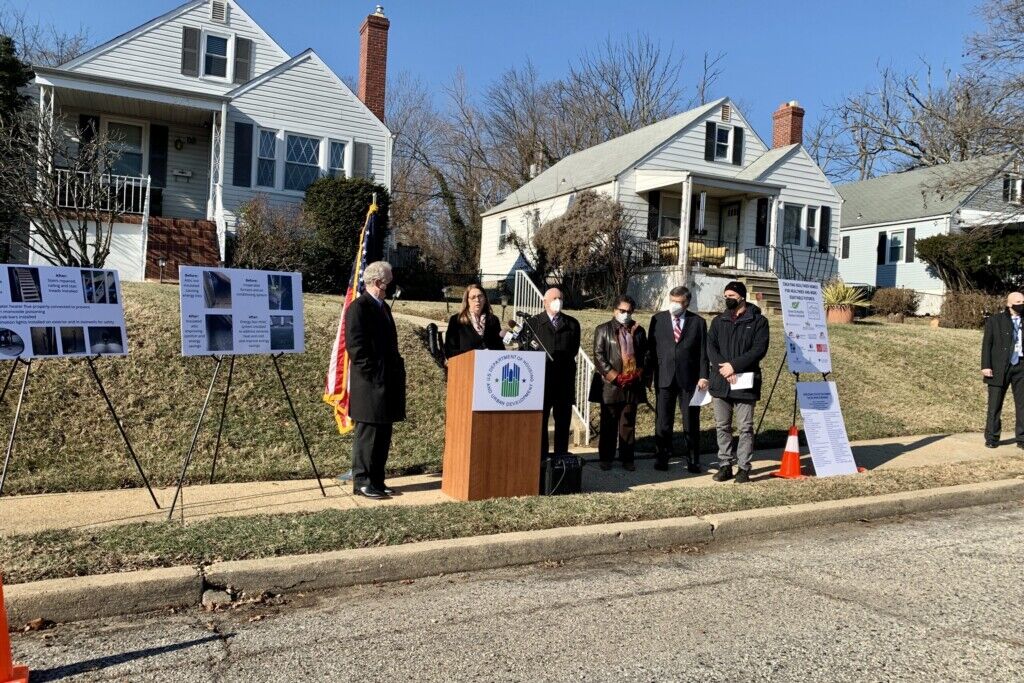This article was republished with permission from WTOP’s news partners at Maryland Matters. Sign up for Maryland Matters’ free email subscription today.

This content was republished with permission from WTOP’s news partners at Maryland Matters. Sign up for Maryland Matters’ free email subscription today.
Deborah Carter-Gaddis sought help after the decades-old roof of her Baltimore home started leaking last fall, but soon learned that her house needed many more upgrades to protect her health and safety.
The Green and Healthy Homes Initiative, a Baltimore-based nonprofit, inspected her home in the Waltherson neighborhood and found mold in the basement from water leaks caused by a defective air conditioning system, corrosion on the hot water heater pipe and a sealed clothing dryer vent, which is a fire hazard.
Gaddis, 73, suffers from chronic obstructive pulmonary disease, which makes it difficult to breathe. Her condition has worsened while living in her home of 16 years, where she takes care of her grandchildren. Her daughter also suffered from respiratory health problems, Gaddis said.
In three months, the Green and Healthy Homes Initiative removed the mold from her basement, connected her hot water heater pipe properly to prevent carbon monoxide poisoning, added grab bars in her bathtub, and installed a new heating and cooling system. In total, the Green and Healthy Homes Initiative spent around $27,000 on Gaddis’s home — at no cost to her.
“On a fixed income, you can’t afford this,” Gaddis said, seated on a big white couch in front of her living room window.
Now, she notices that she does not have to keep her thermometer as high as she used to and can start enjoying her loft again, which either got too cold or too hot. “This is fantastic,” she said, fanning her hands above her and drawing attention to the warm air in her house.
These home repairs will allow Gaddis to live in her home for longer and “have a future where there is generational wealth transfer and equity in her home,” said Ruth Ann Norton, the president of Green and Healthy Homes Initiative, at a press event in front of her house on Monday.
Around 4 million children in the country have household exposure to lead and 40 percent of asthma episodes are caused by triggers at home, according to the Green and Healthy Homes Initiative. African American people with asthma visit the emergency room 6.5 times more often than white people with asthma in Baltimore, according to the organization.
Exposure to lead can damage the brain and kidney and cause anemia, which leads to exhaustion due to the lack of healthy red blood cells. But lead is particularly dangerous to children, whose nervous systems and brains are still developing. In the 1980s, more than 13,000 children in Baltimore were lead-poisoned.
This month, the Green and Healthy Homes Initiative received a $2 million grant from the U.S. Department of Housing and Urban Development to help reduce lead hazards and asthma triggers and make other health improvements at 300 other low-income homes in Baltimore.
The federal agency, which gave a total of $105 million to organizations across 29 states, also granted the Maryland Rural Development Corporation $1.2 million to curtail health hazards in 137 low-income homes in Greensboro, a town of 1,900 people in Caroline County. Enterprise Community Partners Columbia, a Maryland-based national housing nonprofit, also received $2 million to improve 50 low-income homes.
“Children should never have to live in a place where they cannot breathe,” Marcia Fudge, the U.S. Secretary of Housing and Urban Development, said during her visit in Baltimore on Monday.
“There are too many children who die and are disabled every single year because we’ve not done what we should do,” she continued. “When we transform houses, we transform people.”
President Biden’s domestic spending bill, known as Build Back Better Act, includes a $5 billion proposal to replace millions of lead pipes across the nation. Early municipal water systems commonly used lead in pipes, which can contaminate drinking water, until those pipes were banned by Congress in 1986. Still, up to 10 million homes connect to water through lead pipes according to the Biden administration.
Last year, Congress earmarked $60 million in its annual budget for the Health Homes Production Grant Program, but have appropriated $90 million for this current fiscal year, said U.S. Sen. Chris Van Hollen (D).
He joined Fudge and other members of the congressional delegation and city lawmakers outside of Gaddis’ home to call attention to federal programs that allow more people to be safe from their own homes.
“She needs to make sure she has more than just a structure with a roof…that it’s a healthy place to live and where she can invite her kids and grandkids in without fear that they’re getting sick,” Van Hollen said.







